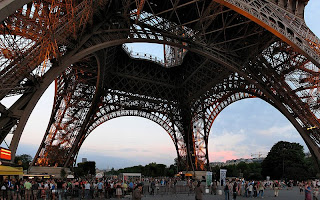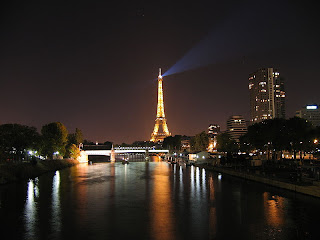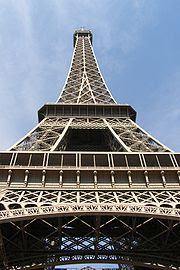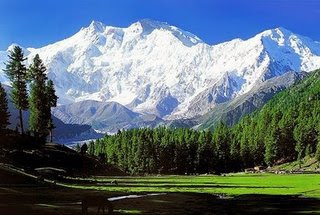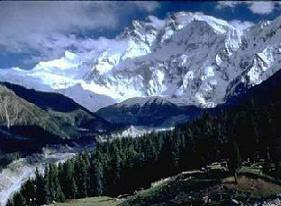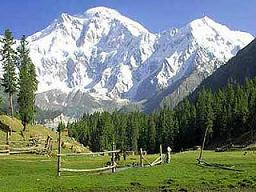The Eiffel Tower is an iron tower built on the Champ de Mars  beside the Seine River in Paris. The tower has become a global icon of France and is one of the most recognizable structures in the world.
beside the Seine River in Paris. The tower has become a global icon of France and is one of the most recognizable structures in the world.
Named after its designer, engineer Gustave Eiffel, the Eiffel Tower is the tallest building in Paris. More than 200,000,000 have visited the tower since its construction in 1889, including 6,719,200 in 2006, making it the most visited paid monument in the world. Including the 24 m (79 ft) antenna, the structure is 325 m (1,063 ft) high (since 2000), which is equivalent to about 81 levels in a conventional building.
When the tower was completed in 1889 it was the world's tallest tower — a title it retained until 1930 when New York City's Chrysler Building (319m —1,047 ft tall) was completed. The tower is now the fifth-tallest structure in France and the tallest structure in Paris, with the second-tallest being the Tour Montparnasse (210 m — 689 ft), although that will soon be surpassed by Tour AXA (225.11 m — 738.36 ft).
The metal structure of the Eiffel Tower weighs 7,300 tonnes while the entire structure including non-metal components is approximately 10,000 tonnes. Depending on the ambient temperature, the top of the tower may shift away from the sun by up to 18 cm (7 in) because of thermal expansion of the metal on the side facing the sun. The tower also sways 6–7 cm (2–3 in) in the wind.
As demonstration of the economy of design, if the 7300 tonnes of the metal structure were melted down it would fill the 125 meter square base to a depth of only 6 cm (2.36 in), assuming a density of the metal to be 7.8 tonnes per cubic meter. The tower has a mass less than the mass of the air contained in a cylinder of the same dimensions, that is 324 meters high and 88.3 meters in radius. The weight of the tower is 10,100 tonnes compared to 10,265 tonnes of air.
The first and second levels are accessible by stairways and lifts. A ticket booth at the south tower base sells tickets to access the stairs which begin at that location. At the first platform the stairs continue up from the east tower and the third level summit is only accessible by lift. From the first or second platform the stairs are open for anyone to ascend or descend regardless of whether they have purchased a lift ticket or stair ticket.
The actual count of stairs includes 9 steps to the ticket booth at the base, 328 steps to the first level, 340 steps to the second level and 18 steps to the lift platform on the second level. When exiting the lift at the third level there are 15 more steps to ascend to the upper observation platform. The step count is printed periodically on the side of the stairs to give an indication of progress of ascent. The majority of the ascent allows for an unhindered view of the area directly beneath and around the tower although some short stretches of the stairway are enclosed.
Maintenance of the tower includes applying 50 to 60 tonnes of paint every seven years to protect it from rust. In order to maintain a uniform appearance to an observer on the ground, three separate colors of paint are used on the tower, with the darkest on the bottom and the lightest at the top. On occasion the colour of the paint is changed; the tower is currently painted a shade of brownish-grey.
On the first floor there are interactive consoles hosting a poll for the colour to use for a future session of painting. The co-architects of the Eiffel Tower are Emile Nouguier, Maurice Koechlin and Stephen Sauvestre.via
Other pictures of Eiffel Tower.
 beside the Seine River in Paris. The tower has become a global icon of France and is one of the most recognizable structures in the world.
beside the Seine River in Paris. The tower has become a global icon of France and is one of the most recognizable structures in the world.Named after its designer, engineer Gustave Eiffel, the Eiffel Tower is the tallest building in Paris. More than 200,000,000 have visited the tower since its construction in 1889, including 6,719,200 in 2006, making it the most visited paid monument in the world. Including the 24 m (79 ft) antenna, the structure is 325 m (1,063 ft) high (since 2000), which is equivalent to about 81 levels in a conventional building.
When the tower was completed in 1889 it was the world's tallest tower — a title it retained until 1930 when New York City's Chrysler Building (319m —1,047 ft tall) was completed. The tower is now the fifth-tallest structure in France and the tallest structure in Paris, with the second-tallest being the Tour Montparnasse (210 m — 689 ft), although that will soon be surpassed by Tour AXA (225.11 m — 738.36 ft).
The metal structure of the Eiffel Tower weighs 7,300 tonnes while the entire structure including non-metal components is approximately 10,000 tonnes. Depending on the ambient temperature, the top of the tower may shift away from the sun by up to 18 cm (7 in) because of thermal expansion of the metal on the side facing the sun. The tower also sways 6–7 cm (2–3 in) in the wind.
As demonstration of the economy of design, if the 7300 tonnes of the metal structure were melted down it would fill the 125 meter square base to a depth of only 6 cm (2.36 in), assuming a density of the metal to be 7.8 tonnes per cubic meter. The tower has a mass less than the mass of the air contained in a cylinder of the same dimensions, that is 324 meters high and 88.3 meters in radius. The weight of the tower is 10,100 tonnes compared to 10,265 tonnes of air.
The first and second levels are accessible by stairways and lifts. A ticket booth at the south tower base sells tickets to access the stairs which begin at that location. At the first platform the stairs continue up from the east tower and the third level summit is only accessible by lift. From the first or second platform the stairs are open for anyone to ascend or descend regardless of whether they have purchased a lift ticket or stair ticket.
The actual count of stairs includes 9 steps to the ticket booth at the base, 328 steps to the first level, 340 steps to the second level and 18 steps to the lift platform on the second level. When exiting the lift at the third level there are 15 more steps to ascend to the upper observation platform. The step count is printed periodically on the side of the stairs to give an indication of progress of ascent. The majority of the ascent allows for an unhindered view of the area directly beneath and around the tower although some short stretches of the stairway are enclosed.
Maintenance of the tower includes applying 50 to 60 tonnes of paint every seven years to protect it from rust. In order to maintain a uniform appearance to an observer on the ground, three separate colors of paint are used on the tower, with the darkest on the bottom and the lightest at the top. On occasion the colour of the paint is changed; the tower is currently painted a shade of brownish-grey.
On the first floor there are interactive consoles hosting a poll for the colour to use for a future session of painting. The co-architects of the Eiffel Tower are Emile Nouguier, Maurice Koechlin and Stephen Sauvestre.via
Other pictures of Eiffel Tower.
 Grab our feeds now!
Grab our feeds now!